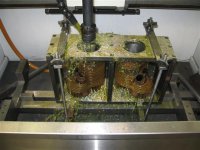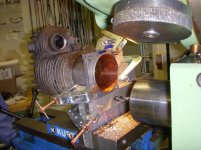I have to TIG weld a significant missing chuck of aluminum on the base of the cylinder of a 70-year old motorcycle, clean up the bore, then press the sleeve in. The welding will distort at least one end of the aluminum cylinder resulting in it being egg-shaped and hourglass-shaped to some extent. However, if I am able to mount it in the lathe afterwards with its undulating-and-imperfect bore being, on average, precisely parallel with the axis of the lathe it will require the minimum amount of metal to be removed. The current interference fit is 0.002" so there isn't much room for material removal (although an oversize sleeve may be available).
Clearly, if the bore were a perfect cylindrical surface I could easily adjust it to within a tenth in a 4-jaw chuck. But, leaving aside issues of stress relieving, whether there might be too much distortion for a subsequent press fit of the sleeve, trying to find a replacement cylinder instead, etc., my question is simply how best to "index" an imperfect internal cylindrical surface when mounting the repaired piece in the lathe.
Assume that all the usual lathe attachments are available (chucks, live and dead centers, faceplates, etc.), and that measurements will be made manually. The bore and length of the cylinder are approximately 3⅜" and 6", respectively. Or, after removing the bulk of the TIG-added material in the lathe, would it be better (i.e. remove less material) to restore the internal surface using my Sunnen hone rather than my lathe? I have the necessary AN-600 Honing Head.
Clearly, if the bore were a perfect cylindrical surface I could easily adjust it to within a tenth in a 4-jaw chuck. But, leaving aside issues of stress relieving, whether there might be too much distortion for a subsequent press fit of the sleeve, trying to find a replacement cylinder instead, etc., my question is simply how best to "index" an imperfect internal cylindrical surface when mounting the repaired piece in the lathe.
Assume that all the usual lathe attachments are available (chucks, live and dead centers, faceplates, etc.), and that measurements will be made manually. The bore and length of the cylinder are approximately 3⅜" and 6", respectively. Or, after removing the bulk of the TIG-added material in the lathe, would it be better (i.e. remove less material) to restore the internal surface using my Sunnen hone rather than my lathe? I have the necessary AN-600 Honing Head.




